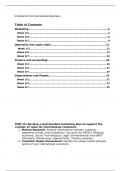Introduction to international business
Table of Contents
Marketing....................................................................................4
Week 2/3.............................................................................................4
Week 4/5.............................................................................................6
Week 6/7.............................................................................................9
Operation and suply chain...........................................................11
Week 2/3..........................................................................................11
Week 4/5...........................................................................................14
Week 6/7...........................................................................................19
Finance and accounting..............................................................24
Week 2/3...........................................................................................24
Week 4/5...........................................................................................27
Week 6/7...........................................................................................29
Organisation and People.............................................................31
Week 2/3...........................................................................................31
Week 4/5...........................................................................................33
Week 6/7...........................................................................................35
TWM 15: Develop a well-founded marketing plan to support the
creation of value for international customers
1. Market Research: Analyze international markets, customer
segments, trends, and competition. Use tools like PESTLE (Political,
Economic, Social, Technological, Legal, Environmental) and SWOT
(Strengths, Weaknesses, Opportunities, Threats) analyses.
2. Customer Needs Assessment: Identify the unique needs and pain
points of your international customers.
, 3. Value Proposition: Create a value proposition that addresses these
needs and differentiates your product or service.
4. Marketing Mix (4Ps): Develop strategies around Product, Price,
Place, and Promotion tailored to the international market.
5. Implementation Plan: Create a timeline, assign resources, and
determine key performance indicators (KPIs) to track the plan's
success.
TWM 18: Evaluate the financial performance of the organization
from different stakeholders' perspectives
1. Identify Stakeholders: Include shareholders, customers, employees,
suppliers, and the community.
2. Financial Metrics: Use metrics like return on investment (ROI), net
profit margin, and earnings per share (EPS) to measure shareholder
interests.
3. Customer Perspective: Evaluate revenue growth, customer
acquisition cost (CAC), and customer lifetime value (CLV).
4. Employee Perspective: Analyze labor costs, turnover rates, and
compensation compared to industry benchmarks.
5. Supplier Perspective: Review payment terms, supply chain stability,
and vendor relationship management.
TWM 20: Evaluate operations and supply chain processes within and
between organizations
1. Map Processes: Identify the key operations and supply chain
activities within and between organizations (e.g., procurement,
production, distribution).
2. Evaluate Efficiency: Use metrics like lead times, cycle times,
inventory turnover, and cost efficiency.
3. Benchmarking: Compare your processes against industry standards
or best practices to evaluate performance gaps.
4. Risk Management: Identify vulnerabilities in the supply chain, such
as supplier reliability or geopolitical risks.
TWM 21: Manage operations and supply chain processes within and
between organizations
1. Process Optimization: Implement lean manufacturing, Six Sigma, or
other process improvement methodologies to streamline operations.
2. Supply Chain Coordination: Work closely with suppliers and
partners, using technologies like ERP (Enterprise Resource Planning)
and SCM (Supply Chain Management) systems.
3. Sustainability Initiatives: Incorporate sustainable practices into the
supply chain, like reducing carbon footprints and promoting ethical
sourcing.
4. Technology Integration: Utilize digital tools for real-time inventory
tracking, demand forecasting, and resource planning.
TWM 22: Draft the strategic cycle of part(s) of the organization
(process and content)
1. Strategic Planning Cycle: Develop a cycle that includes:
, o Environmental Scanning: Assess internal and external factors
(SWOT, PESTLE).
o Strategy Formulation: Set long-term goals and objectives
based on insights.
o Strategy Implementation: Allocate resources, establish
timelines, and assign responsibilities.
o Monitoring and Control: Track performance against objectives
using KPIs.
2. Process Focus: Select a specific area (e.g., marketing, operations,
supply chain) and break down its strategic cycle, outlining processes
from initiation to review.
3. Feedback Loops: Ensure that each phase in the cycle feeds back into
the planning phase for continuous improvement.
, Marketing
Week 2/3
Steps in the Marketing Process
1. Understanding the Marketplace and Customer Needs:
o Research customer needs, wants, and demands.
o Understand the market environment, competition, and trends.
o Identify customer problems that your product or service can
solve.
2. Designing a Customer-Driven Marketing Strategy:
o Segmentation: Divide the market into distinct groups of buyers
with different needs.
o Targeting: Select the segments to enter and serve.
o Positioning: Differentiate your offering in the mind of your
target audience.
o Value Proposition: Create a compelling value proposition to
attract customers.
3. Constructing an Integrated Marketing Program:
o Develop a marketing mix using the 4Ps: Product, Price, Place,
and Promotion.
o Ensure that the marketing tools work together to deliver a
cohesive value proposition.
4. Building Customer Relationships:
o Engage with customers through continuous relationship-building
strategies.
o Focus on customer satisfaction, loyalty, and retention.
o Leverage CRM (Customer Relationship Management) tools to
maintain ongoing customer interaction.
5. Capturing Value from Customers:
o Achieve customer loyalty and repeat business.
o Generate profits and customer equity by delivering superior
customer value.
o Expand the customer base through word of mouth and referrals.
Importance of Understanding the Marketplace and Customers
Understanding the marketplace and customers is essential because:
Customer Needs and Wants: Businesses can only create successful
products when they understand what customers truly need or desire.
Competitive Advantage: By knowing competitors and market
conditions, a company can position itself effectively and develop
unique offerings.




